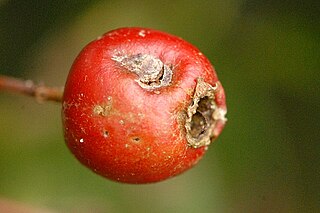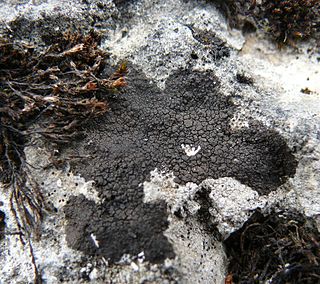Related Research Articles

Sordariomycetes is a class of fungi in the subdivision Pezizomycotina (Ascomycota). It is the second-largest class of Ascomycota, with a worldwide distribution that mostly accommodates terrestrial based taxa, although several can also be found in aquatic habitats. Some are phytopathogens that can cause leaf, stem, and root diseases in a wide variety of hosts, while other genera can cause diseases in arthropods and mammals.
Ainsworthia is a genus of fungi in the family Chaetothyriaceae.

The Venturiaceae are a family of fungi in the order Pleosporales. Several of the species in this family are plant pathogens.

The Pleosporales is the largest order in the fungal class Dothideomycetes. By a 2008 estimate, it contained 23 families, 332 genera and more than 4700 species. The majority of species are saprobes on decaying plant material in fresh water, marine, or terrestrial environments, but several species are also associated with living plants as parasites, epiphytes or endophytes. The best studied species cause plant diseases on important agricultural crops e.g. Cochliobolus heterostrophus, causing southern corn leaf blight on maize, Phaeosphaeria nodorum causing glume blotch on wheat and Leptosphaeria maculans causing a stem canker on cabbage crops (Brassica). Some species of Pleosporales occur on animal dung and a small number occur as lichens and rock-inhabiting fungi.

Pleosporaceae is a family of sac fungi.

The Roccellaceae are a family of fungi in the order Arthoniomycetes. Most taxa are lichenized with green algae, although some are lichenicolous, growing on other lichens.

Verrucariaceae is a family of lichens and a few non-lichenised fungi in the order Verrucariales. The lichens have a wide variety of thallus forms, from crustose (crust-like) to foliose (bushy) and squamulose (scaly). Most of them grow on land, some in freshwater and a few in the sea. Many are free-living but there are some species that are parasites on other lichens, while one marine species always lives together with a leafy green alga.

Gnomoniaceae is a family of fungi in the order Diaporthales. The family was circumscribed by German botanist Heinrich Georg Winter in 1886.
Phaeochorella is a genus of fungi It was formerly placed in the family Phyllachoraceae, before in 2020 placed in the monotypic family of Phaeochorellaceae.
Sphaerodothis is a genus of fungi in the family Phyllachoraceae.

Leptosphaerulina is a genus of fungi in the class Dothideomycetes. The relationship of this taxon to other taxa within the class was unknown in 2007 until it was placed within the Didymellaceae family in the Pleosporales order. The genus was first described by Australian plant pathologist Daniel McAlpine in 1902.
Cyclotheca is a genus of fungi in the Microthyriaceae family.
Palawania is a genus of fungi in the Parmulariaceae family.
Muyocopron is a genus of fungi in the Muyocopronaceae family.
Trichopeltospora is a genus of fungi in the Microthyriaceae family; according to the 2007 Outline of Ascomycota, the placement in this family is uncertain.
The Lulworthiaceae are a family of marine fungi in the Ascomycota, class Sordariomycetes. Species in the family have a widespread distribution in both temperate and tropical oceans, and are typically found growing on submerged wood or on seaweed. In 2000, Molecular analysis of several species of Lulworthia and Lindra led to the reassignment of their parent genera to the new order Lulworthiales in addition to the new family Lulworthiaceae. In 2020, a large fungi study added more genera to the family.

The Chaetosphaeriaceae are a family of fungi in the Ascomycota, class Sordariomycetes. The family was circumscribed by Martina Réblová, Margaret Elizabeth Barr Bigelow, and Gary Samuels in 1999. Species in the family have a cosmopolitan distribution, and are found in both temperate and tropical climates. Fossils of the Chaetosphaeriaceae are known from the Carboniferous, Eocene, Oligocene, Miocene and more recent sediments.
Vizella is a genus of leaf-inhabiting fungi in the class Dothideomycetes, and the type genus of the family Vizellaceae. The genus was circumscribed by Pier Andrea Saccardo in 1883.
Asterostomella is a genus of fungi in the Asterinaceae family. The relationship of this taxon to other taxa within the class is unknown, and it has not yet been placed with certainty into any order. They are leaf parasites. Such as Asterostomella miliusaeA.K. Singh, Kamal & Shiv K. Singh (1982) is found on Miliusa tomentosa(Roxb.) Finet & Gagnep. plants in India as a type of 'black mildew'.
Etheirophoraceae is a family of ascomycetous marine based fungi within the order of Torpedosporales in the subclass Hypocreomycetidae and within the class Sordariomycetes. They are saprobic on intertidal wood and bark within marine habitats.
References
- ↑ Lumbsch TH, Huhndorf SM. (December 2007). "Outline of Ascomycota – 2007". Myconet. Chicago, USA: The Field Museum, Department of Botany. 13: 1–58.
- 1 2 "Saccardiaceae". www.gbif.org. Retrieved 20 July 2022.